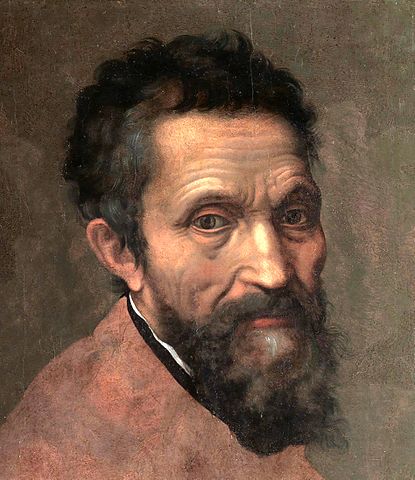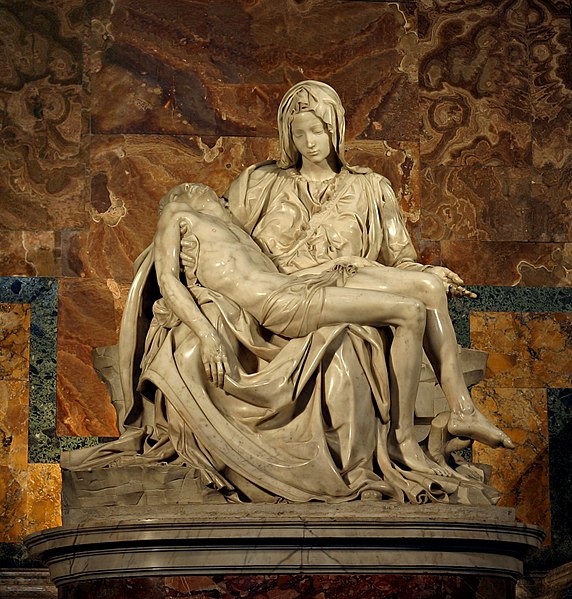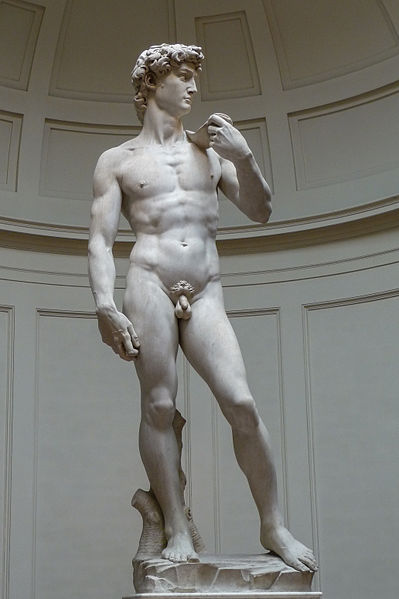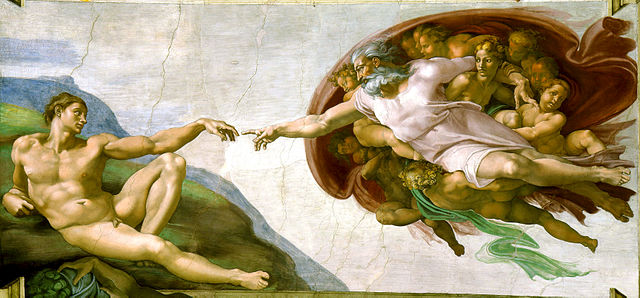
Michelangelo di Lodovico Buonarroti Simoni or more commonly known by his first name Michelangelo (March 6, 1475 – February 18, 1564) was an Italian sculptor, painter, architect, and poet of the High Renaissance born and raised in the Republic of Florence. He highly influenced the development of Western art. Considered to be the greatest living artist during his own lifetime, he is acknowledged as one of the greatest artists of all time. His versatility made him the archetypical Renaissance man (along with his rival, fellow Florentine and client of the Medici, Leonardo da Vinci).
After his mother’s prolonged illness and death in 1481 (when he was six years old), Michelangelo lived with a nanny and her husband, a stonecutter, in the town of Settignano, where his father owned a marble quarry and a small farm. There he gained his love for marble.
Later, Michelangelo was sent to Florence to study under a tutor. However, he showed no interest in his schooling, preferring to copy paintings from churches and seek the company of other painters.
The city of Florence was Italy’s center of the arts and learning. The Signoria (the town council), the merchant guilds, and wealthy patrons such as the Medici and their banking associates, commissioned works of art. The Renaissance, characterized by a renewed interest in Classical scholarship and the arts, first blossomed in Florence.
During Michelangelo’s early life, a team of painters was called from Florence to the Vatican to decorate the walls of the Sistine Chapel. Among them was Domenico Ghirlandaio, a master in fresco painting, perspective, figure drawing and portraiture who had the largest workshop in Florence. In 1488, at age 13, Michelangelo was apprenticed to Ghirlandaio. The next year, his father persuaded Ghirlandaio to pay Michelangelo as an artist, which was rare for someone only fourteen years old. When in 1489, Lorenzo de’ Medici, de facto ruler of Florence, asked Ghirlandaio for his two best pupils, Ghirlandaio sent Michelangelo and Francesco Granacci.

Portrait of Michelangelo by Daniele da Volterra
From 1490 to 1492, Michelangelo attended the Humanist academy founded by the Medici. There his work and worldview were influenced by many of the most prominent philosophers and writers of the day. When he was seventeen, another pupil struck him on the nose, causing permanent disfigurement that is noticeable in portraits of Michelangelo.
At Lorenzo de’ Medici’s death in 1492, Michelangelo left the security of the Medici court and returned to his father’s house. In the following months, he carved a polychrome wooden Crucifix (1493) as a gift to the prior of the Florentine church of Santo Spirito, which had allowed him to do anatomical studies of the corpses from the church’s hospital. In 1494, after heavy snowfalls, Lorenzo’s heir, Piero de Medici, commissioned a snow statue, and Michelangelo again entered the court of the Medici.
In the same year, the Medici were expelled from Florence as the result of the rise of Savonarola, a colorful Dominican friar who was known for his prophecies of civic glory, the destruction of secular art and culture, and his calls for Christian renewal. Michelangelo left the city before the end of the political upheaval, moving to Venice and then to Bologna. Toward the end of 1494, the political situation in Florence calmed, and Michelangelo returned to Florence but received no commissions from the new city government under Savonarola. He returned to the employment of the Medici. During the half year he spent in Florence, he worked on two small statues, a child St. John the Baptist and a sleeping Cupid. Allegedly Lorenzo di Pierfrancesco de’ Medici, for whom Michelangelo had sculpted St. John the Baptist, asked that Michelangelo make it look as if it had been buried so he could sell it in Rome as an antiquity. The buyer, Cardinal Raffaele Riario, discovered that it was a fraud, but was so impressed by the quality of the sculpture that he invited the artist to Rome in 1496.

Pietà by Michelangelo; photo by Stanislav Traykov, used under Creative Commons Attribution-Share Alike 3.0 Unported license
In November 1497, the French ambassador to the Vatican, Cardinal Jean de Bilheres-Lagraulas, commissioned Michelangelo to carve a Pietà, a sculpture showing the Virgin Mary grieving over the body of Jesus. Michelangelo was 24 when he finished it. Soon it was regarded as one of the world’s great masterpieces of sculpture. It is now located in St Peter’s Basilica.
Michelangelo returned to Florence in 1499. He was asked by the consuls of the Guild of Wool to complete an unfinished project begun 40 years earlier by Agostino di Duccio: a colossal statue of Carrara marble portraying David as a symbol of Florentine freedom. Michelangelo completed his statue of David in 1504. The masterwork definitively established his prominence as a sculptor of extraordinary technical skill.

David by Michelangelo; photo by Jorg Bittner Unna, used under Creative Commons Attribution-Share Alike 3.0 Unported license
In 1505 Michelangelo was invited back to Rome by the newly elected Pope Julius II and commissioned to build the Pope’s tomb, which was to include forty statues and be finished in five years. Under the patronage of the pope, Michelangelo experienced constant interruptions to his work on the tomb in order to accomplish numerous other tasks. Although Michelangelo worked on the tomb for 40 years, it was never finished to his satisfaction.
During the same period, Michelangelo painted the ceiling of the Sistine Chapel, which took approximately four years to complete (1508–1512). Michelangelo was originally commissioned to paint the Twelve Apostles on the triangular pendentives that supported the ceiling, and to cover the central part of the ceiling with ornament, but he persuaded Pope Julius to give him a free hand and proposed a different and more complex scheme, representing the Creation, the Fall of Man, the Promise of Salvation through the prophets, and the genealogy of Christ.

Ceiling of the Sistine chapel, painted by Michelangelo; photo by Jean-Christophe Benoist, used under Creative Commons Attribution-Share Alike 3.0 Unported license
The composition stretches over 500 square meters of ceiling and contains over 300 figures. At its center are nine depictions from the Book of Genesis, divided into three groups: God’s creation of the earth; God’s creation of humankind and their fall from God’s grace; and lastly, the state of humanity as represented by Noah and his family. On the pendentives supporting the ceiling are painted twelve men and women who prophesied the coming of Jesus, seven prophets of Israel, and five Sibyls, prophetic women of the Classical world.

The Creation of Adam (detail of Sistine Chapel ceiling) by Michelangelo
During his lifetime Michelangelo worked for several successive popes, all members of the Medici family.
Shortly before his death in 1534 Pope Clement VII commissioned Michelangelo to paint a fresco of The Last Judgment on the altar wall of the Sistine Chapel. His successor, Paul III, saw to it that Michelangelo completed the project. The fresco depicts the Second Coming of Christ and his judgment of the souls. Michelangelo ignored the usual artistic conventions in portraying Jesus, showing him as a massive, muscular figure, youthful, beardless and naked. He is surrounded by saints, among whom Saint Bartholomew holds a drooping flayed skin, bearing the likeness of Michelangelo. The dead rise from their graves, to be consigned either to Heaven or to Hell.

The Last Judgment by Michelangelo
Once completed, the portrayal of Christ and the Virgin Mary naked was deemed sacrilegious, and Cardinal Carafa and Monsignor Sernini (Mantua’s ambassador) campaigned to have the fresco removed or censored, but the Pope resisted. At the Council of Trent, shortly before Michelangelo’s death in 1564, it was decided to obscure the genitals and an apprentice of Michelangelo was commissioned to make the alterations.
In 1546, at age 74, Michelangelo was appointed architect of St. Peter’s Basilica, Rome. The process of replacing the original Constantinian basilica of the 4th century had been underway for fifty years and in 1506 foundations had been laid to the plans of Donato Bramante. Successive architects had worked on it, but little progress had been made. Michelangelo revisited the concepts of Bramante, and developed his ideas for a centrally planned church, strengthening the structure both physically and visually.

St. Peter’s Basilica; photo by Myrabella, used under Creative Commons Attribution-Share Alike 3.0 Unported license
As construction progressed on St Peter’s, there was concern that Michelangelo would pass away before the dome was finished. Ultimately, the western end of the basilica and the dome were finished after his death with minor modifications of his design.
The sheer volume of surviving correspondence, sketches, and reminiscences make Michelangelo the best-documented artist of the 16th century. His paintings, sculptures, and architecture rank among the most famous in history and earned him the nickname Il Divino (the divine one).
Information for this article was taken from Wikipedia.
Michelango was a true artist.
LikeLiked by 1 person
I know, right?! Florence and Rome are on my bucket list so I can get my fill of him.
LikeLiked by 1 person